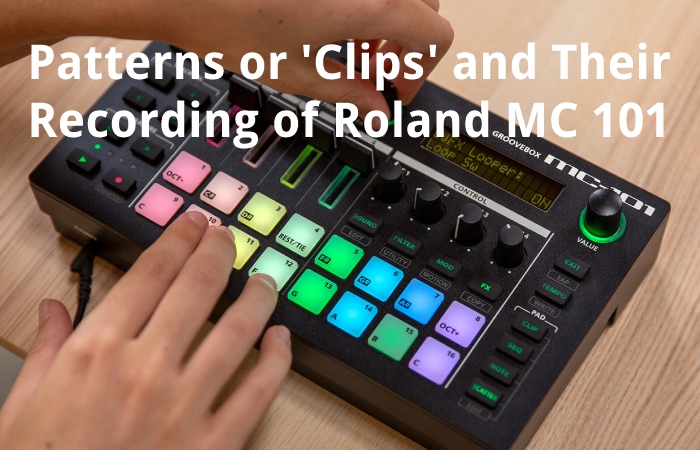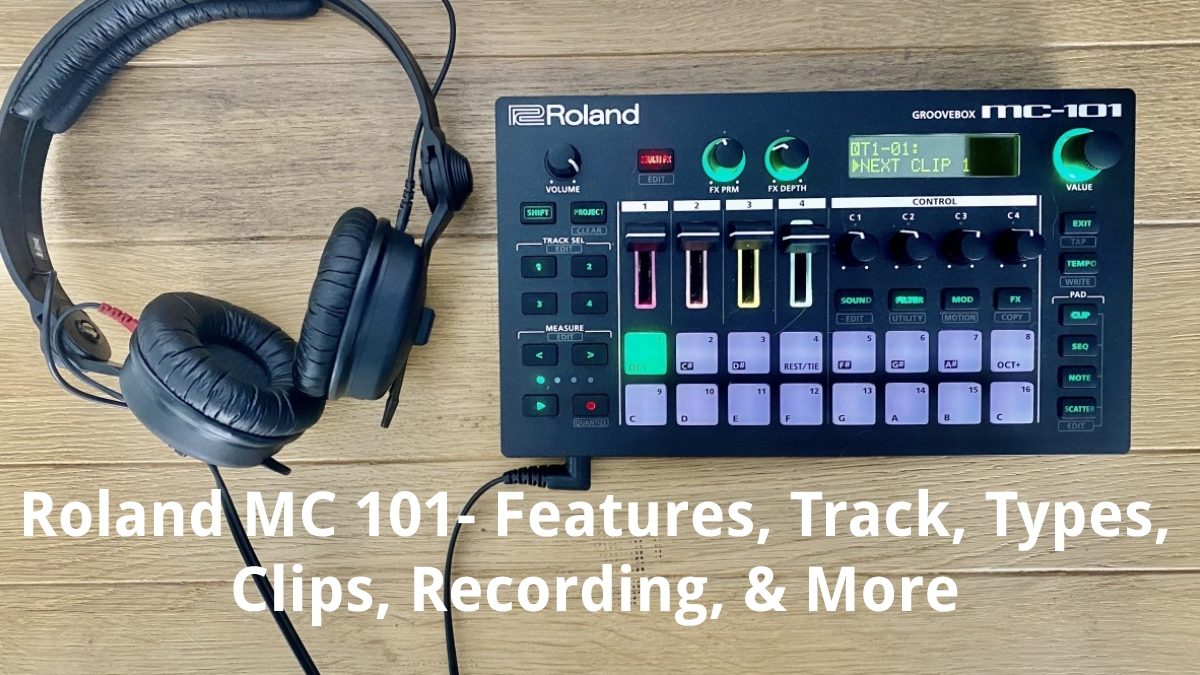Table of Contents
Roland MC 101
Roland mc 101 can comfortably claim to have invented the groove box. If a clear and sufficient definition is feasible, with so many and so different models that manufacturers have devised over time. ‘Groove’ indicates an orientation to the world of electronic music and dance floors, both in the sounds they offer, their sequencer, and the type of workflow. It is pattern-oriented and accessible to fewer keyboard players/pianists. ‘Box’ speaks of a self-contained team capable by itself of solving the creation of a theme or its development live.
With that vocation, Roland has brought together its new MCs: four (MC-101) and eight (MC-707) tracks that can be synthesizers, drums or ‘audio looper’; Ableton Live-style clip management; Zen-Core synthesis; facilities to integrate samples and audio in real-time; rich and complex effects; scatter unit; storage on SD card and a complete audio integration via USB.
Features of Roland MC 101
The groove box returns more than ten years later to the catalogue of the brand that created that name, and it does so twice. MC-101 and MC-707 are two intelligent machines, much more similar to each other than you might expect despite the differences in size. They bring to this groove box format details inherited directly from the latest Roland synths and workstations. This renewal of the synthesis engine is one of the many technical and philosophical changes compared to the already old MC-909, MC-505, or MC-303.
Fitted within the AIRA/DJ range, which by its own will focuses on the world of electronics/DJ, patterns, and live interaction, it is best understood that some functions of those previous generations, to the surprise of those who knew them. With no song mode or configurable chaining of patterns on the machine itself, what’s on offer has more to do with ideas born around Ableton Live’s hugely successful ‘session’ view than with the idea of a song with a fixed and pre-prepared route.
Track Types of Roland MC 101
The four tracks of the MC-101 and the eight of the MC-707, without fixed presets, can use interchangeably as a polyphonic synth track (tone), as a track for using a set of 16 drum/percussion sounds (tracks type ‘drum’, being able to choose in one of them ‘drum’ with compressor dedicate effect, apart from the impact that each track can carry-), or as a ‘ looper’ track capable of using up to 60 seconds of pre-recorded audio or captured in real-time to repeat it in tempo with the other ways thanks to automatic time-stretching and pitch-shifting functions.
Zen-Core Synthesis
The synthesis for the ‘tone’ and ‘drum’ is based on the Zen-Core system recently launched by Roland and that we already present to you. It represents an exciting update of what we had been conceiving as synthesis in workstations (multisampling, high polyphony, complexity with several simultaneous parts within a sound, hundreds of highly detailed parameters, etc.).
It starts from the structures already known at Roland with sounds or ‘tones’ based on bringing together 4 ‘partials’ (each a complete set of oscillator, filter, LFOs and envelopes). But in Zen-Core, we can choose the oscillators and filters of those partials with the traditional and digital workstations.
Sounds
The preset sounds are the same on the MC-10 and MC-707. They are presented in various categories like pianos, organs, etc. and include a pervasive and broken down list of synth sounds. The search is streamlined by using those families as a filter. The sounds also organize in AE banks of different lengths and content. In bank A we find a bit of everything very close at hand, with 178 varies sounds. Bank B contains 451 mostly synth sounds and label AX.
Bank C combines 121 sounds from Jupiter, Juno, Bassline TB-303, SH-101, and D-50 recreate from Zen-Core. A dedicated bank of 1,109 synth sounds, and banks E and F offer 896 and 837 typical PCM-based workstation sounds, featuring real instruments and complex combinations.
Patterns or ‘Clips’ and Their Recording of Roland MC 101

The recording is not of the ‘linear’ type but pattern oriented, here called ‘clips’. They are individual per track, not a pattern as an entire multi-track arrangement, but ‘clips’ of a single instrument/drum kit/loop. Think of Ableton Live, and you will not be misguide. Typically each track will play a role (drums, bass, etc.) and will have up to 16 clips to offer different versions and sections for a song.
The clips are here (despite Roland’s website indicating 64 in the specifications) of 128 steps, equivalent to 8 bars complete with sixteenth note steps. Much more generous than so many pattern products that have their maximum at 32 or 64. Indeed, the pattern philosophy does not allow long extensions to record or play uninterruptedly. Still, those 128 steps are a more than welcome relief for those who enjoy developments or progressions a bit more spacious.
Projects and Storage of Roland MC 101
Along with the notes and CCs, the clips also contain the full detail of the sound and effect they use. Without us having to keep them in any sound bank. That way, a project file is always self-contained and without dependencies.
Also, since each clip has sounds and effects, the same track can use depending on the hook we launch with different timbres and effects. It expands the possibilities within the same project. Having eight tracks does not imply a limit to 8 sounds because of each clip. I can use (instead, contain and therefore use) a different one. Indeed looking for the most incredible possible simplicity. It avoids burdening the user with the need to save sounds, effects, clips, etc. separately.
Selecting and Grouping Clips
Each project of the new MC allows you to store up to 16 of these ‘clips’ in each of its tracks to combine them as you like on the fly. It is a clear undisguised heritage of the interactive mode (‘session’) of Ableton Live that is so applied in music sessions and DJs worldwide. The clips represent different phrases and musical motifs we can collect, one from each track, as we wish.
The clips played at each moment are chosen by selecting them through the double row of pads. In which act as a window to offer a partial view of the large total matrix of tracks/clips (16 rows by four rows). Or eight tracks). We have already seen an idea in so many controllers for Live that no one misses. The large screen of the MC-707 represents that matrix and makes it easier to use. It but is complicated to manage on the MC-101. If we minimally order in the location of the clips to make our lives easier.
Clip Interaction
Although elaborating and creating patterns will almost always be a task before performing. If these new MCs’ vocation is to play with the designs live. That we can go on selecting and combining one pattern after another, regulating their ‘mutes’ and levels. An altering here and their sound parameters and the many effects present, or animating the results through that ‘scatter’ that Roland accompanies in several. It is their recent products which help get multiple nods to the DJ.
Effects
The effects’ quality, variety, and number are incredibly high, as Roland. I have already accustomed to their high-end synths and workstations. There are five shares globally: reverb and delay towards. In which the sending from each track can adjust, equalization and compression after mixing all the tracks, and the possibility. Is activating a third insert effect to choose from among 90 types.
Differences Between MC-101 vs MC-707
The two machines, beyond the different number of tracks (4/8) and the question. The controls’ size, number, and functions share architecture but from other approaches. In MC-101, portability prevails, and it is possible to use it with batteries. Curiously, despite the much small screen size. The letters on the MC-101 are much larger than those on the MC-707. In which certain proximity is necessary for comfortable reading.
In the limited space of the MC-101, there are logically fewer controls, and editing is somewhat more involved. If so it has the same scope as the MC-707 except for the synthesis parameters. Limited to editing three dozen parameters. It is out of the question on the MC-101 to create a sound from scratch or edit it 100%. Which is doable on the MC-707. Elsewhere, everything the 707 can do is possible on the 101.
Conclusion
I don’t know if many will need to clarify at this point what a groove box is Roland MC 101. The idea germinated with the MC‑202 combination of synth, internal sequencer, and portability. The earlier Micro Composers, the MC‑4 and MC‑8, were pure sequencers, notable. In being the first to digitally control and disguised as supermarket tills.

